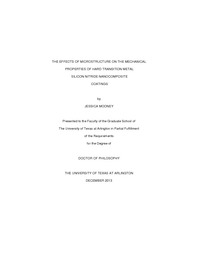
ATTENTION: The works hosted here are being migrated to a new repository that will consolidate resources, improve discoverability, and better show UTA's research impact on the global community. We will update authors as the migration progresses. Please see MavMatrix for more information.
Show simple item record
| dc.contributor.author | Mooney, Jessica | en_US |
| dc.date.accessioned | 2014-03-12T23:48:44Z | |
| dc.date.available | 2014-03-12T23:48:44Z | |
| dc.date.issued | 2014-03-12 | |
| dc.date.submitted | January 2013 | en_US |
| dc.identifier.other | DISS-12453 | en_US |
| dc.identifier.uri | http://hdl.handle.net/10106/24074 | |
| dc.description.abstract | In this body of work, the examination of two different transition metal silicon nitride (MeSiN) systems using two different methods of physical vapor deposition (PVD) allowed for the development of a detailed understanding between the processing conditions, the micro-scale and nano-scale morphology, and the mechanical properties of the as-deposited thin film nanocomposite coatings. TiSiN coatings processed using the high-energy Arc deposition technique had hardness values of up to 33.6 GPa, and a previously unidentified (TiSi)N FCC crystalline phase, likely present due to the amounts of energy employed during coating processing, was discovered via intensive low angle X-Ray diffraction (XRD) and high resolution transmission electron microscopy (HRTEM) study. Coating morphology was columnar, and the presence of nano-scale subgrains within the columns was established, with increasing Si content within the coatings serving to reduce and refine both column and subgrain microstructure.TiSiN coatings prepared in the Surface and Nano Engineering Laboratory (SaNEL) via reactive PVD magnetron sputtering had even more impressive mechanical properties, with refinements to deposition parameters and the coating microstructure yielding thin film materials up to 38.9 GPa in hardness. Relationships between the preferred orientation, the presence of the (TiSi)N FCC crystal structure, the hardness, and the residual stress of the coatings were discovered and explored in detail, with the overwhelmingly present trend of higher hardness and higher degree of (200) FCC texturing being correlated with lower residual stresses and less prominent presence of Si incorporation into the FCC TiN crystal lattice. Morphology was again columnar, with nano-scale subgrain presence detected within the columns.The knowledge gained via the study of the TiSiN system was used to select initial processing conditions for another type of MeSiN coating, TaSiN. Initial coatings possessed hardness ranging from 20-25.5 GPa, and displayed excellent oxidation resistance after ambient air annealing at 550˚C. Continued study of this system is ongoing, but preliminary recent results suggest that the refinement of the structure to include a combination of FCC, hexagonal, and orthorhombic TaN crystalline phases serves to increase TaSiN coating hardness to levels of approximately 33 GPa. | en_US |
| dc.description.sponsorship | Meletis, Efstathios | en_US |
| dc.language.iso | en | en_US |
| dc.publisher | Materials Science & Engineering | en_US |
| dc.title | The Effects Of Microstructure On The Mechanical Properties Of Hard Transition Metal Silicon Nitride Nanocomposite Coatings | en_US |
| dc.type | Ph.D. | en_US |
| dc.contributor.committeeChair | Meletis, Efstathios | en_US |
| dc.degree.department | Materials Science & Engineering | en_US |
| dc.degree.discipline | Materials Science & Engineering | en_US |
| dc.degree.grantor | University of Texas at Arlington | en_US |
| dc.degree.level | doctoral | en_US |
| dc.degree.name | Ph.D. | en_US |
Files in this item
- Name:
- Mooney_uta_2502D_12453.pdf
- Size:
- 4.881Mb
- Format:
- PDF
This item appears in the following Collection(s)
Show simple item record


